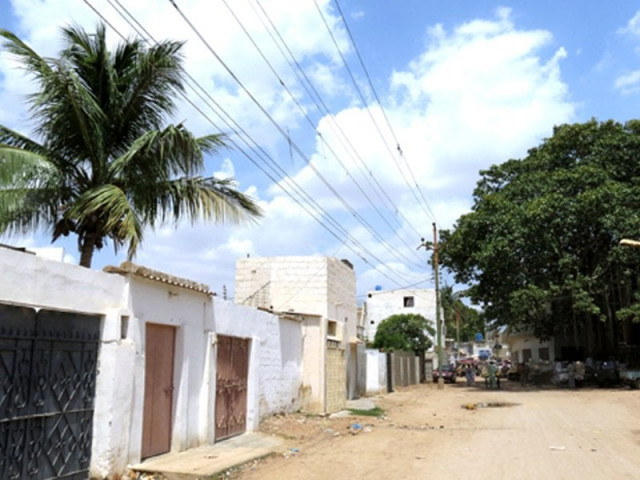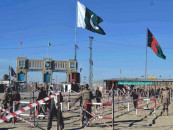What Toronto and Karachi may have in common
A Cityminded.org webinar talks about breathing life into old, heritage neighbourhoods.

Martin Quarters is located between Teen Hatti and Gurumandir in Karachi. Photo: Zairah Maher.
Its roads, alleyways and streets are wide, old custard apple and banyan trees dot the landscape, children play cricket outside without cars running them down. An imambargah gives the area a feeling of community. People recognise each other's children. Neighbours borrow sugar.
Yes, it is a poor neighbourhood and the sewage system needs an overhaul but it always struck me as a place where there was a sense of community. Of course, this feeling ebbs and flows with exits and arrivals, new faces and squabbles.
Martin Quarters came to mind during a webinar I attended June 12. And while its speakers were Canadian and talked mostly about Toronto, I came away from the session with the overwhelming sense that so many of Karachi's neighbourhoods had exactly the same characteristics the experts were highlighting.
The webinar was held by Cityminded.org to talk about whether the technology that already exists in heritage neighbourhoods can help shape the future of sustainability. These are words that urbanists love globally but which I struggle with in Karachi. I interpret them as looking at what it is about old neighbourhoods, the way their houses were designed, the width of their roads, their planning, that made them good places to live in.
According to Cityminded.org, a sustainable community is one where there is a balanced mix of activities, fossil fuel use is reduced and walking or cycling is given a higher priority. These communities are energy efficient, minimise the use and disposal of water and treat waste as a resource. I couldn't think of a single place in Karachi, which had achieved this.
I am interested in sustainability because Karachi scares the living daylights out of me. How are we going to keep this up, I wonder each day. It is one of the world's megacities and as we have been warned, by 2050 70% of our global population will live in cities. No wonder the conversation is about how we must make them livable, resilient, sustainable, happy, healthy, green places to live in.
In the webinar, David Waverman, a senior cultural heritage specialist and landscape architect with Golder Associates in Canada, talked about some examples of how they had worked with heritage neighbourhoods.
"The greenest building is the building already built," he said. He found that some of the heritage districts happen to be the greenest neighbourhoods in Canada.
When you walk through them you see old buildings and streets lined with trees but that is just the surface.

Heritage districts in Ontario are some of the most desirable pieces of real estate. And because of this demand, it becomes all the more important to conserve them. IMAGE: David Waverman of Golder Associates
Waverman's team has been involved in the study and creation of several heritage districts in southwest Ontario. They studied their visual context, traffic patterns, history, cultural landscape, talked to neighbourhood groups, stakeholders, local municipal heritage committees. As expected, it became abundantly clear that these places had a sense of history, place and belonging.
"We've learnt that there is a real love for the human scale of the architecture," he said.
Some key reasons were the mature trees and vegetation, the style and charm of the built form, the walkability and the overall urban design of the neighbourhood, said Waverman. "In industrial neighbourhoods where the aesthetics are not as significant a factor," he added, "they heard of the narrative told by the built forms or the industry that built these neighbourhoods."
In heritage districts you go for walks that weave past neighbourhood parks, schoolyards. People walk to the local pub or grocery store, reducing the need for parking spaces. There are cafes and small shops. It is in these neighbourhoods that people spend time in public spaces, lending them a sense of community. It also makes them safer.

The streets are wide and don't have too many cars rushing around on them. PHOTO: Zairah Maher
It was in this sense that I thought Martin Quarters was a good neighbourhood. Its streets are wide and don't have too many cars rushing around on them. There are enough men, young boys and children in the common spaces to make it a safe place. The MQM's unit office and party workers keep a vigilant eye on comings and goings, which contributes to the overall safety of the neighbourhood. On Friday, one main artery is dedicated to the congregational prayers.
People walk to the grocery store, hang out on stoops. While there may not be quaint cafes, there used to be a guy with a stall selling potato fries at one point. Vegetable vendors wheel their carts door-to-door selling cauliflowers, eggplant, gourd.

And while second stories have been added to the houses, the entire neighbourhood is generally 'human scale'. There are no high-rises in sight and you feel the breeze blow over the neighbourhood.
But most beautiful of all are the old trees here. It almost seems as if houses have been built around them. In fact, I found one growing right through a house, its massive trunk smack in the middle and its leafy branches providing a beautiful natural shade from the sun.
And so, I wondered, has Martin Quarters been overlooked and been condemned as a 'colony' as we say in Karachi.
It is not as if Toronto's neighbourhoods are all well planned, resilient and sustainable. In the webinar, Ron Dembo, the founder and CEO of Zerofootprint, talked about that part of Toronto that faces the water.

Ron Dembo argues that the city and Toronto’s water should have been integrated. Image: Zerofootprint
"This area became available for redevelopment and the city had two choices," he said. But instead of integrating the city and water on human scale development, nondescript high rises came up. (In Karachi the same has happened with a mall coming up by the waterfront at Sea View). The problem with high rises is that people on different floors don't know each other. This neighbourhood doesn't have the sense of community and vibrancy that the older ones have.
It is possible, as Dembo's former company Algorithmics Inc. also proved, to be able to revitalise a neighbourhood by fixing up an old building. (See also about Toronto’s roundhouse below). In his case it was a derelict multi-story located on the edge of China Town. It was going to be sold for a song to Algorithmics Inc. which was going to take advantage of a brilliant new regulation that allowed the neighbourhood to become mixed use (think commercial versus residential).

The building on the edge of Toronto’s Chinatown before and after Ron Dembo’s former company renovated it.
Dembo was warned the building was in the “most dangerous” part of Toronto. But they went ahead and renovated it. The building came to be known as a part of a high-tech mecca or Toronto’s ‘Silicon Alley’. According to Dembo, you couldn't walk into one of the many new coffee shops that sprung up without meeting someone you would end up sharing ideas with. This was the best of what we love about cities - they become hubs for innovation. It certainly helped that the building was just a stone's throw away was Queens Street, which is full of people, little stores and restaurants.
Dembo felt this area was a resilient neighbourhood because of its network of activities that are so "tight that they are hard to break”. “I walk into the coffee store and I know the owner," he said. "It's like a tight web that holds the place together." Perhaps many of Karachi's neighbourhoods have this without even knowing it.


These two images show the peak of the railway land development. By 1920, Canadian Pacific and Canadian National Railyards occupied the south of the city and employed one of three working men to move goods across North America.
Creative repurposing and the case of the Toronto Roundhouse
Don Loucks, an architect, urban designer and heritage planner with the IBI Group, gave the webinar the example of the creative repurposing of a heritage site, the Roundhouse in Toronto. And while the example is not of a neighbourhood, it shows how new life can be breathed into a piece of abandoned heritage.
A roundhouse is a building used to service locomotives. Back in the day the locomotives could only move forward not reverse, so the roundhouse's turntable was important to 'turn them around' for the journey back.
The place where it is located in Toronto started out as a harbour and was under water. In the first part of the 1900s the harbour was filled and the railways started to proliferate along the south side of Toronto.
The Roundhouse doors closed in 1988. But in 1991 it was declared a heritage site and one of the finest surviving roundhouses in Canada. "It was not derelict at that point, but a post-industrial landscape that the city hadn't decided what to do with," said Louks.
It was partially demolished or dissembled and a convention centre was built below it. When that was finished, the 30,000 sq feet of the Roundhouse was reassembled. A brewery was added. And then, ten years later, finally the IBI Group was hired to renovate the remaining 80,000 sq ft. The place was fixed up, a railway heritage centre and a large furniture showroom were added to it. And thus, from a harbour bed, to a bustling railway yard, to a green space with a brewery, museum, park and playground, the Roundhouse site became an example of the sustainability of adaptive reuse.
Published in The Express Tribune, June 21st, 2013.



















COMMENTS
Comments are moderated and generally will be posted if they are on-topic and not abusive.
For more information, please see our Comments FAQ